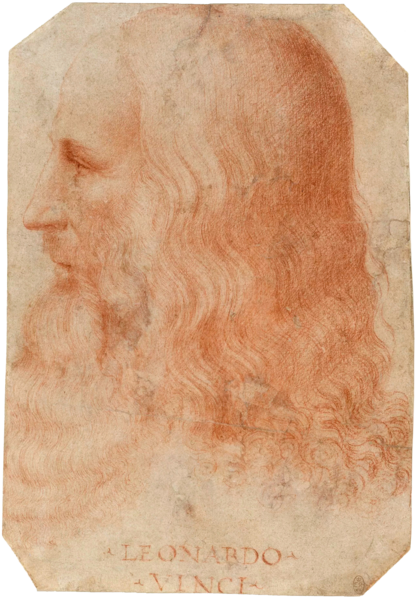
Born: 15 April 1452, Vinci, Florence
Died: 2 May 1519 (aged 67)
Period: Renaissance
The Life of Leonardo da Vinci
Leonardo da Vinci, born on April 15, 1452, in Vinci, Italy, was a polymath whose interests and contributions spanned various fields including art, science, engineering, anatomy, and invention, making him a leading figure of the Italian Renaissance.
Early Life and Training Leonardo was the illegitimate son of a notary, Piero da Vinci, and a peasant woman, Caterina. Early in his life, he received an informal education in Latin, mathematics, and geometry. Around the age of 14, he became an apprentice to the renowned artist Andrea del Verrocchio in Florence, where he acquired a diverse set of skills, including metalworking, leather arts, carpentry, drawing, painting, and sculpting.
Artistic Career Leonardo’s artistic career is marked by a series of groundbreaking works that displayed his innovative techniques and deep understanding of the human body, nature, and scientific principles. His ability to blend art and science distinguished his work from his contemporaries. Notable paintings from his early period in Florence include the “Annunciation” and “The Adoration of the Magi.”
In 1482, Leonardo moved to Milan, serving Ludovico Sforza, where he produced some of his most famous works, such as “The Last Supper,” a masterpiece of composition and narrative. During this time, Leonardo also engaged in scientific studies, anatomical sketches, and mechanical invention designs.
Studies and Scientific Work Leonardo’s notebooks, filled with over 20,000 pages of drawings and notes, reveal his genius in understanding the principles of nature and mechanics. He studied the human body, including detailed anatomical drawings and studies on muscles, tendons, and the vascular system. His scientific investigations also covered botany, geology, zoology, hydraulics, aeronautics, and physics. He conceptualized flying machines, a type of armored vehicle, concentrated solar power, an adding machine, and the double hull, amongst many other visionary ideas.
Later Years In 1513, Leonardo moved to Rome, where he was provided with a workshop by Pope Leo X. In 1517, he accepted an invitation from King François I of France to enter his service. Leonardo spent his last years in Amboise, France, at the Clos Lucé, near the king’s residence. He continued to work on scientific studies and was honored as a distinguished painter and engineer at the royal court.
Leonardo da Vinci died on May 2, 1519, in Amboise. His legacy is vast, encompassing significant contributions to various fields. As an artist, he is best remembered for his masterpieces such as “The Last Supper” and the “Mona Lisa,” which continue to fascinate and inspire due to their technical excellence and profound expression. As a scientist and inventor, Leonardo’s forward-thinking ideas were centuries ahead of their time, though many were never realized within his lifetime. His approach to blending scientific inquiry with art has made him a symbol of the Renaissance spirit, embodying the limitless potential of the human mind.
Leonardo da Vinci’s Notable Works
Leonardo da Vinci is celebrated not only for his revolutionary approach to art and science but also for a body of work that has left an indelible mark on the history of Western art. Here are ten of his most famous works, each illustrating his mastery over various disciplines and his insatiable curiosity about the world:
- “Mona Lisa” (c. 1503-1506) – Perhaps the most renowned painting in the world, housed in the Louvre, Paris. Known for its subject’s enigmatic expression and the mastery of sfumato technique.
- “The Last Supper” (1495-1498) – A mural in Milan’s Convent of Santa Maria delle Grazie that captures the emotional and dynamic moment of Jesus announcing that one of his disciples would betray him.
- “Vitruvian Man” (c. 1490) – A drawing that embodies the blend of art and science, illustrating the ideal human body proportions as described by the ancient Roman architect Vitruvius.
- “The Lady with an Ermine” (c. 1489-1490) – A portrait of Cecilia Gallerani, showcasing Leonardo’s talent in capturing character and the use of chiaroscuro.
- “Ginevra de’ Benci” (c. 1474-1478) – Housed in the National Gallery of Art, Washington, D.C., this portrait is celebrated for its depiction of the sitter’s personality and the subtle use of color.
- “St. John the Baptist” (1513-1516) – One of Leonardo’s last paintings, noted for its use of sfumato and the androgynous representation of St. John.
- “The Baptism of Christ” (c. 1472-1475) – Although primarily painted by his master Verrocchio, Leonardo contributed significant elements, showcasing his early mastery.
- “Annunciation” (c. 1472-1475) – An early work that depicts the angel Gabriel’s announcement to Mary, highlighting Leonardo’s understanding of perspective and anatomy.
- “The Adoration of the Magi” (unfinished, 1481) – An unfinished work that still demonstrates his innovative approach to composition and his interest in human emotion.
- “The Battle of Anghiari” (lost work, 1503-1506) – Known only through copies and sketches, this mural was to depict a historic Florentine military victory and is celebrated for its dynamic composition and powerful depiction of motion and emotion.
Leonardo’s works transcend the boundaries of art, science, and technology, reflecting a life dedicated to the pursuit of knowledge and beauty. His legacy is not just in the paintings he left behind but also in his notebooks, filled with sketches, scientific diagrams, and ideas that would not be realized for centuries.